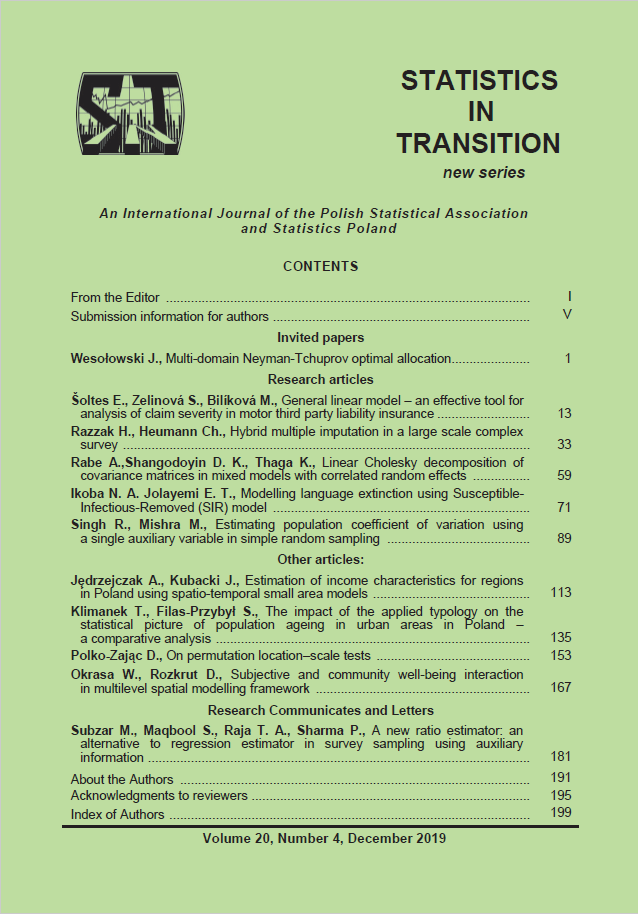ARTICLE
ABSTRACT
The study presents a stochastic epidemic model applied to the model of indigenous language extinction. The Susceptible-Infectious-Removed (SIR) categorization of an endemic disease has been reformulated to capture the dynamics of indigenous language decline, based on the assumption of non-homogeneous mixing. The time in which an indigenous language is expected to be extinct was derived using a modified SIR model with the population segmented into several sub-communities of small sizes representing family units. The data obtained from the 2016 indigenous language survey conducted in several parts of Nigeria and from the 2013 Nigeria Demographic Health Survey (NDHS) were used to estimate the key parameters of the model for Nigeria’s several indigenous languages. The parameters of interest included the basic reproduction number, the threshold of endemicity, and the time in which a language is expected to be extinct, starting from the endemic level. On the basis of the time in which a language is expected to be extinct, several of the surveyed languages appeared to be in a precarious condition, while others seemed virile, thanks to a high language transfer quotient within families.
KEYWORDS
language extinction, stochastic epidemic model; non-homogeneous mixing, quasi-stationary distribution, time in which a language is expected to be extinct
REFERENCES
ALLEN, L., BURGIN, A. M., (2000). Comparison of Deterministic and Stochastic SIS and SIR Models in Discrete Time. Mathematical Biosciences, 163, pp. 1–33.
ANDERSSON, H., BRITTON, T., (2000). Stochastic Epidemic Models and Their Statistical Analysis, Lecture Notes, Department of Mathematics, Stockholm University, Sweden.
BALL, F. G., LYNE, O. D., (2000). Stochastic Multitype SIR Epidemics among a Population Partitioned into Households, Adv. in App. Prob., 33, pp. 99–123.
BILLINGS, L., MIER-Y-TERAN-ROMERO, L., LINDLEY, B., SCHWARTZ, I., (2013). Intervention-Based Stochastic Disease Eradication, PLoS ONE 8(8): e70211.
BURR, T. L., CHOWELL, G., (2008). Signatures of Non-Homogeneous Mixing in Disease Outbreaks. Mathematical and Computer Modelling, 48, pp. 122–140.
CRYSTAL, D., (2000). Language Death, New York: Cambridge University Press.
DALEY, D. J., KENDALL, D. G., (1964). Epidemics and Rumours. Nature, 204 (4963), 1118.
DOBSON, A. P., CARPER, E. R., (1996). Infectious Diseases and Human Population History, BioScience, 46(2), pp. 115–126.
HAGENAARS, T. J., DONNELY, C. A., FERGUSON, N. M., (2004). Spatial Heterogeneity and the Persistence of Infectious Diseases. J. Theo. Bio., 203, pp. 33–50.
LEWIS, M. PAUL, GARY F., SIMONS, CHARLES, D. FENNIG, (eds.)., (2015). Ethnologue: Languages of the World, Eighteenth edition. Dallas, Texas: SIL International. www.ethnologue.com.
LINDHOLM, M., (2007). Stochastic epidemic models for endemic diseases: the effect of population heterogeneities. Research Report 2007:10, Licentiate thesis, Department of Mathematics, Stockholm University, Sweden.
LINDHOLM, M., BRITTON, T., (2007). Endemic persistence or disease extinction: the effect of separation into families, Theo. Pop. Bio., 72, pp. 253–263.
NASELL, I., (1999). On the time to extinction in recurrent epidemics. Journal of the Royal Statistical Society, B 61, pp. 309–330.
NASELL, I., (2002). Stochastic Models of Some Endemic Infections. Mathematical Biosciences, 179, pp. 1–19
NASELL, I., (2005). A new look at the critical community size for childhood infections. Theoretical Population Biology, 67, pp. 203–216. National Population Commission, (2014). Nigeria Demographic and Health Survey 2013. Published by National Population Commission (Nigeria) and ICF International, www.npc.gov.ng.
NUWER, R., (2014, May 6). Why We Must Save Dying Languages. Retrieved from www.bbc.co.uk.
OHIRI-ANICHE, C., (2014). More than 400 Nigerian Indigenous Languages Endangered, Vanguard Newspaper, Nigeria, www.vanguardngr.com, 26-04-14.
SCHWARTZ, I. B., BILLINGS, L., DYKMAN, M., LANDSMAN, A., (2009). Predicting Extinction Rates in Stochastic Epidemic Models. Journal of Statistical Mechanics: Theory and Experiment, www.stacks.iop.org/JSTAT/2009/P01005 .
VERDASCA, J. A., TELO DA GAMA, M. M., NUNES, A., BERNADINO, N. R., PACHECO, J. M., GOMES, M. C., (2005). Recurrent Epidemics in Small World Networks, J. Theor. Biol., 233(4), pp. 553–561.
